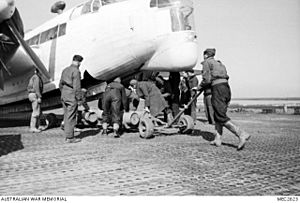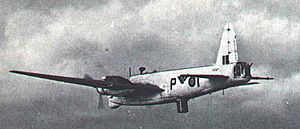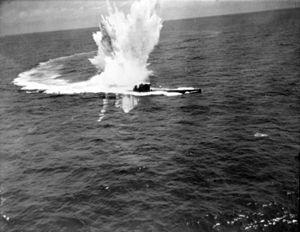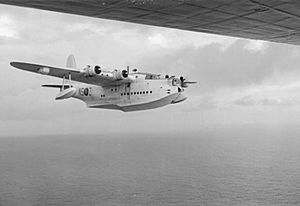ASV Mark III radar facts for kids
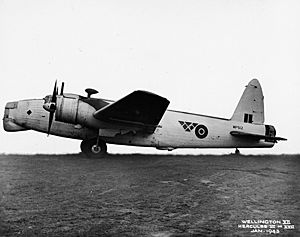
Wellington XII MP512 was one of the first aircraft to be fitted with ASV Mk. III
|
|
| Country of origin | UK |
|---|---|
| Introduced | 1943 |
| Type | Sea-surface search |
| Frequency | 3300 ±50 MHz (S-band) |
| PRF | 660 pps |
| Beamwidth | ~10º horizontal, ~15º vertical |
| Pulsewidth | 1 µs |
| RPM | 60 rpm |
| Range | 1 to 100 mi (1.6–160.9 km) |
| Diameter | 28 in (0.71 m) |
| Azimuth | 320º |
| Precision | ~5º |
| Power | 40 kW |
| Other Names | ARI.5119, ARI.5153 |
| Related | ASV Mark VI |
ASV Mark III was a special radar system. It was used by RAF Coastal Command during World War II. This radar helped planes find enemy U-boats (submarines) on the ocean surface.
It was a changed version of the H2S radar. That radar was used by RAF Bomber Command. ASV Mk. III had small changes to its antenna. These changes made it better for finding submarines. It became Coastal Command's main radar from 1943 until the war ended. Later, improved versions like ASV Mark VI and ASV Mark VII were also used.
Coastal Command's first radar was ASV Mark I. It started being tested in 1939. The Mark II version came out in 1940. But it was not widely used until late 1941. German U-boats soon found a way to detect these radars. They used a device called Metox radar detector. This device warned them when a plane was coming. Submarines could then dive and hide. This made the older radars useless.
A new ASV radar was being developed. It used microwaves and a new device called a cavity magnetron. This new radar was called ASVS. Robert Hanbury Brown suggested using the H2S radar for ASV. Bomber Command first said no. But when Metox made older radars useless, Brown pushed for it again. The first ASV Mark III units were ready in March 1943. Soon, most older radars were replaced.
The Germans could not detect Mark III signals. This radar used a much shorter wavelength (10 cm). The older Mk. II used a longer wavelength (1.5 m). A captured RAF officer also tricked the Germans. He said the British could detect their Metox device. This caused a lot of confusion for the Germans. Along with other new technologies, submarine losses went up fast in 1943. By the time Germans figured out the truth, their U-boat force was almost destroyed. The Battle of the Atlantic was nearly over. The Germans later made Naxos. It was a microwave detector. But it was not very good. Mark III continued to help Coastal Command planes find U-boats.
Contents
How the ASV Radar Was Developed
Early ASV Radars
Work on the first ASV radars began in 1937. A team was testing an air-to-air radar. They noticed strange signals near the English Channel. They realized these were from docks and cranes far away. They also saw ships. But their plane was not allowed to fly over water. So, they used two Avro Anson planes for more tests. The first system was simple. A basic antenna was held out a window. It was swung by hand to find targets.
The radar's wavelength worked well over water. Ships were good targets because they were large and flat. After more work on antennas, the system was ready by early 1939. The first ASV Mark I radars were used in combat in January 1940. This was the first time aircraft radar was used in a real battle. An improved version, Mark II, came out in 1941.
The early ASV radars had a problem. Submarines would disappear from the screen when the plane got too close. This made it hard to attack at night. The Leigh Light solved this. It was a powerful searchlight. It lit up submarines in the last moments of an attack. By early 1942, many planes had ASV Mark II and the Leigh Light. German U-boats had been safe at night. But now, planes would appear suddenly and attack them.
The Germans found a way to beat ASV Mark II. They used the Metox radar detector. This device picked up the radar's signals. It played them in the radio operator's headphones. Operators could tell if a plane was coming. This warning came long before the submarine appeared on the plane's radar. This allowed U-boats to dive and escape.
The First Mark III Idea
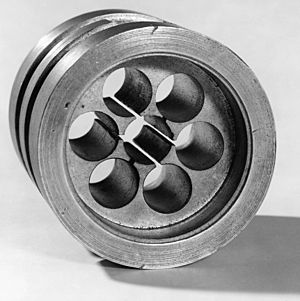
In 1940, the cavity magnetron was invented. It made microwaves at about 10 cm. British forces started making radars using these devices. Teams working on ASV radar also began developing a new system. They called it ASVS, with 'S' for "centimetric" (meaning using very short waves). Tests in April 1941 showed it could find submarines partly underwater. It could detect them from several miles away.
In June 1941, a group was formed to develop ASVS. It was meant to be like Mark II. But it would use the magnetron as a transmitter. It would still use two antennas. The stronger signal from one antenna would show the target's direction.
At the same time, the TRE (Telecommunications Research Establishment) was making H2S radar. H2S had a plan-position indicator (PPI). This showed a map-like view of the ground. The PPI made it much easier for operators. ASVS soon got the PPI display too. It used a 9-inch screen for the map. A smaller 6-inch screen showed only the range.
H2S was for new, large bombers. Older bombers like the Wellington went to Coastal Command. The new bombers had a big hole in their belly for a gun turret. The H2S antenna fit there. The Wellington's turret hole was smaller. So, the main change was making the antenna smaller. It went from 36 inches to 28 inches wide. Otherwise, the units were similar to H2S Mark I.
Tests began in December 1941. By January 1942, the ASVS could see a small ship at 12 miles. This success led to orders for production. Ferranti would make the electronics. Metropolitan Vickers would make the scanning antenna. This system would be called ASV Mark III. Ferranti had a test version ready by summer 1942. But they thought it would not be ready for delivery until spring 1943.
Testing the New ASVS
Tests continued with the ASVS. In March 1942, it was tested against other ASV radars. One was Mark IIA. It had a stronger transmitter. It increased power from 7 to 100 kW. This doubled the detection range for surfaced submarines. But it also made more clutter from waves. Another unit used a 50 cm wavelength. But it showed no benefits over the basic Mark II.
The ASVS system showed huge improvements. It could detect convoys at 40 miles. This was true even when the plane flew low (500 feet). Other planes were seen at 10 miles. Surfaced submarines were detected at 12 miles. ASVS was immediately chosen as the new main radar. The 50 cm system was cancelled.
The H2S Becomes the New Mark III
Robert Hanbury Brown believed the H2S radar could be used for anti-shipping. It just needed a different antenna. This antenna would be for planes flying at 2,000 feet. He worked with the H2S developers at EMI.
By late 1942, Metox was being used. Ferranti said their Mark III would not be ready soon. Brown's H2S-based system was almost done. A few hand-built units could be ready by the end of 1942. This 10 cm system would be invisible to Metox. A meeting was held in September 1942. It was decided to use the H2S-based system. It would also be called Mark III. Ferranti was told to stop work on their design.
There was a big debate about using the magnetron. If a plane with H2S was shot down, Germans could copy it. But for ASV, the magnetron would likely fall into the water. This made ASV a safer choice for using the few magnetrons available. Arthur "Bomber" Harris of Bomber Command objected. He thought bombing U-boat pens was better. But Coastal Command was given priority for the magnetron units.
There were also problems within Coastal Command. They were upset that the original Mark III project was cancelled. The commander, Philip Joubert de la Ferté, even said he did not believe in ASV. He demanded to see it in action. The TRE teams suggested putting the new radar on four-engine planes. These planes had more room and longer range. But Joubert insisted on using the two-engine Wellington.
ASV Mark III in Action
First Flights and Challenges
The Wellington planes used with ASV Mark III also had a new Leigh Light. It was moved from the wing to a retractable "dustbin" under the plane. This meant the radar scanner could not be placed there. So, the radar was moved to the nose. This blocked scanning to the rear. It also meant the nose guns had to be removed. Pilots did not like losing these guns.
By December 1942, a few units were ready. They were installed on Wellington VIIIs. Testing began in January. The H2S and ASV systems were very similar. Both had two screens. A 6-inch screen for the main radar display. A smaller 3-inch screen for altitude. This smaller screen was also used to time the Leigh Light.
Coastal Command's priority for the radar was short-lived. In January 1943, Bomber Command got priority again. There were not enough technicians to keep the units working. So, more technicians were trained. They even trained on a similar US radar, the DMS-1000.
The first mission with the new radar was on March 1, 1943. The plane returned without finding submarines. But the radar operator helped the pilot avoid German night fighters. On March 17, a plane spotted a submarine at 9 miles. But its Leigh Light failed. The next night, the same plane found a submarine at 7 miles. It dropped depth charges. More magnetrons became available in March 1943. Deliveries were split equally between commands. A lack of spare parts became a problem. But it was solved by sending more spares to Bomber Command. They had higher loss rates.
Turning the Tide of the War
By the end of March, No. 172 Squadron RAF had Mark III radars. They started attacking submarines every week. In April, sightings in the Bay of Biscay increased sharply. It seemed planes were finding every submarine. Around this time, similar US radars arrived. These DMS-1000s were on Consolidated B-24 Liberator planes. These planes had enough range to cover the Mid-Atlantic gap. This allowed planes to protect convoys all the way across the Atlantic. A B-24 with DMS-1000 was used by No. 224 Squadron RAF. They called it ASV Mark IV.
The US Army Air Corps later cancelled DMS-1000. They chose another radar, the SCR-517. But it was not as good. The RAF learned of another US radar, the Philco ASG. It was similar to the DMS-1000. They asked for ASG on their Liberator orders. They called it ASV Mark V. In March, Liberators with different radars arrived. They started service in June. These planes did not have the Leigh Light. So, they could not always attack. But they were great at disrupting U-boats. They also called in ships to attack them.
By May 1943, U-boats faced attacks from the moment they left port. Even in the Atlantic, they were attacked far from convoys. This was combined with new ships. These ships had microwave radars and huff-duff receivers. This made U-boat operations very hard. Attacking convoys became almost impossible.
Karl Dönitz, the German U-boat commander, was confused. He knew a new detection system was being used. But he did not know what it was. In May 1943, he told Hitler:
We are facing the greatest crisis in submarine warfare. The enemy's detection devices make fighting impossible. They are causing us heavy losses.
Dönitz ordered U-boats to leave port during the day. This way, they could try to shoot down planes. German day fighters could also protect them. Coastal Command responded with "Strike Wings." These were fast planes like the Bristol Beaufighter. They attacked in small groups. They overwhelmed U-boat defenses. They were also hard for German fighters to hit. U-boat losses kept climbing.
In June, U-boats started leaving port in groups of five or more. This gave them more anti-aircraft fire. But it also made them easier to detect. The RAF planes would stay away. They would call in destroyers to sink the U-boats. If U-boats tried to dive, planes would attack. For U-boats that escaped the Bay, attacking convoys was nearly impossible. Every attempt to form wolfpacks was stopped. Shipping losses to U-boats dropped sharply. In June, fewer ships were lost than at any time since 1941. By the end of the month, 30% of the U-boat force at sea was lost. This was a disaster. Dönitz had to pull his fleet from the North Atlantic.
British Trick, German Confusion
In February 1943, German submarine U-333 was attacked by a Mk. III Wellington. The U-boat shot down the plane. But the plane dropped charges. The submarine survived. It reported that Metox gave no warning. The Leigh Light was not used. The plane just appeared and dropped bombs. On March 7, U-156 was attacked similarly. It radioed that a new radar was likely being used.
Despite these warnings, German efforts were slowed by a clever trick. A captured Coastal Command captain made up a story. He said they no longer used Mk. II for finding submarines. Instead, they used a new receiver. It listened for tiny signals leaking from the Metox's tuner. He claimed it could detect Metox from 90 miles away. The radar was only turned on at the last minute. It was just to check range and help the Leigh Light.
At first, Germans doubted this. But lab tests showed it was possible. Equipment was put in a plane. It detected Metox at 70 miles. The extra 20 miles claimed was blamed on British electronics.
From then on, this false information was believed. This was true even with evidence against it. Some U-boats were attacked with their Metox turned off. One radio operator detected strange signals outside the normal range. But on August 15, 1943, a message told the entire fleet to turn off their Metox.
The Germans knew about the magnetron. They knew it was used for new high-frequency radars. An intact magnetron fell into German hands in February 1943. It was from a Short Stirling plane with H2S radar. For some reason, the German Navy did not think this system would be used for anti-submarine work.
German Countermeasures
Believing the problem was Metox leakage, U-boats got Wanze detectors. These detected signals in the 120-150 cm range. They also had less signal leakage and better range. But U-boat sinkings continued. In November 1943, Wanze was also banned. They thought it might also be tracked. A new version, Wanze G2, had even less leakage. But it had less range and did not help. Borkum was introduced in summer 1943. It detected signals between 75 and 300 cm. This was still outside the Mk. III's range. Borkum was less sensitive than Wanze. But it had very low leakage. Command felt it was safe to use. Still, sinkings continued.
Only in September 1943 did the German navy think about 10 cm signals. The Luftwaffe was using Naxos. It helped their night fighters track H2S radars. The receiver was changed for a new antenna. It was introduced that month. Naxos had very short-range detection, about 8 km. So, even if it detected Mk. III, there was little time to dive. Also, the Naxos antenna was fragile. It had to be removed to dive. Naxos was never a good solution to the Mark III problem.
Improved Versions of ASV Mark III
Mark IIIA
Soon after the first Mark IIIs, a small improvement was added. This created the Mark IIIA, or ARI.5153. The main difference was the Lucero system. Lucero was a transceiver. It was tuned to 1.5 m band radio beacons. These were used for navigation and IFF Mark III (friend or foe identification). Lucero sent out signals near 176 MHz. It could also switch to the Blind Approach Beacon System (BABS) at 173.5 MHz. Ground beacons would reply with a strong pulse. Lucero picked up this pulse. It sent it to the ASV or H2S height scope.
Lucero used two antennas. A motor switched between them. This created two "blips" on the screen. By comparing their size, the operator could find the beacon's direction. Lucero helped planes navigate back to airfields from far away. As more beacons were used, the radio spectrum became crowded. This led to new Lucero versions. They worked with the Rebecca/Eureka system at 214-234 MHz.
Mark IIIB
By late 1943, H2S radar had many improvements. These included better antennas and waveguides. Waveguides improved signal strength. There was also roll stabilization. This kept the image steady when the plane moved. A "north-up" display was added. And height-corrected displays showed ground distance. Most of these were not needed for ASV. ASV planes flew low. So, slant range was close to ground distance.
Coastal Command did not need these H2S improvements. So, H2S and ASV became separate lines. The first custom ASV system was Mark IIIB. This version had a new control. It let the operator expand the "zero ring." This kept the target blip near the edge of the display. This made the blip larger. It improved accuracy from 6° to about 1.7° in the last 1,000 feet. Other changes were small.
Mark IIIC
By 1943, the Short Sunderland flying boat was a key part of Coastal Command. These planes used ASV Mark II. Its antennas were under the wings or on the fuselage. Mark III had a problem. Its nose and belly locations could not be used. This was because of the flying boat's hull. So, a changed version called Mark IIIC was made.
Mark IIIC used two scanners. One was under each outer wing. Their rotation was linked. The radio signal switched between them as they rotated. The signal was sent by a magnetron. It went to the scanners through a waveguide in the Sunderland's wing. In tests in April 1944, IIIC performed much better than Mk. IIIs on Wellington and Halifax planes. It was almost twice as good. The reasons for this were never fully known.
Sea Return Discriminator
Large waves have vertical sides. They reflect radar well. This causes false signals on the display. In rough seas, the screen could fill with noise. This made the system useless. So, a "sea return discriminator" was tested. It filtered out low-frequency signals. This reduced clutter from waves. In March 1944 tests, it removed wave clutter in medium seas. It greatly reduced it in high seas. It also reduced target signals. But a good operator could adjust it. This allowed them to still track targets.
Replacing ASV Mark III
When Metox first appeared, the TRE looked for ways to defeat it. One idea was ASV Mark IIA. It was a more powerful Mk. II. It had an "attenuator" called "Vixen." This allowed the operator to reduce the radar's power. It made it seem like the plane was just flying by. The second idea was to use a new frequency. This became the Mk. III. In tests in January 1942, Mark III was better. Mk. IIA was dropped.
When Mark III was introduced, its developers thought Germans would soon detect its signals. They thought the cycle would repeat. So, they started developing new models. These would be ready if Germans found a counter. Like Mark II, they considered two solutions. A more powerful Mark III with an attenuator. And a move to a new frequency. These became Mark VI and Mark VII.
It was not until October 1943 that RAF crews noticed "disappearing contacts" again. This was due to Naxos. This delay was unexpected. Both Mark VI and VII were well developed. Mark VI was first installed on Wellingtons in February 1944. Still, Naxos was never as effective as Metox. Mark III remained the most used system until the end of the war.
Mark VI
Two types of attenuators were made for Mark VI. Type 53 used two wire rings. They were placed around the waveguide. When rotated, they could mute the signal. These loops also weakened the received signal. So, a more powerful 200 kW magnetron was used. The original was 40 kW. An improved attenuator, Type 58, allowed the loops to be switched out. This let the full signal reach the receiver. With the new magnetron, Type 58 units had much better range than original Mk III.
A "lock-follow" system was also added. Operators found it hard to read the blips and guide the plane. Mark VIA added a lobe switching system. It used two close antennas. They measured small signal differences. This directly guided the motors turning the antenna. Once on, the system automatically followed the target. It was much more accurate than human operators. But the system had problems. It was not ready until after D-Day. By then, U-boat bases in Biscay were abandoned.
Mark VII
Another solution was to move to a new frequency. This became possible in 1943. New magnetrons for the 3 cm X-band became available. These were already being tested for X band H2S. Moving to 3 cm offered a huge advantage. Radar's sharpness depends on antenna size and wavelength. The 28-inch antenna of ASV made a beam about 10° wide. A submarine's signal came from anywhere within this 10° arc. The blip on the screen was a wide arc, not a dot. Other large objects could also make arcs. These might overlap the target. In rough seas, large waves could hide the submarine. Moving to 3 cm made the beam about 3° wide. This made the arcs much shorter. Only waves very close could hide the submarine. This made the radar work better in rough seas.
The advantages of X-band were clear. But Bomber Command also wanted these magnetrons. Coastal Command would likely lose the argument for UK-built units. So, Mk. VII was not mass-produced. Instead, similar X-band units from the US were preferred. The few units made during development were used for air-sea rescue planes. Their higher resolution helped them find small lifeboats.
How ASV Mark III Worked
Mark III vs. H2S Mark II
The first Mark III was like the H2S Mark II. The main difference was the antenna. H2S used a 36-inch reflector. It spread the signal wide to cover the area below the bomber. ASV changed this design. It was 28 inches wide. It sent less energy downward. This was because ASV planes flew low. The area under the plane was small. Another change was how power was sent to the antenna. This change was later added to H2S Mark IIA. The Mark IIIC on the Sunderland had two different antennas. They were fed by a waveguide through the wing. A special switch sent the magnetron's signal to each scanner as it rotated.
Inside the Radar System
The ASV/H2S system had four main parts in eleven packages. The "Waveform Generator Type 26" was the main clock. It triggered the magnetron. It switched the system from sending to receiving. It also started the display on the screen. The radar signal came from the 40 kW magnetron. This was in the "Transmitter/Receiver" unit. This unit also had a klystron. Magnetrons produce slightly different signals each time. The klystron picked up some of the signal. It made a steady reference signal for the receiver.
The Transmitter/Receiver also handled the first part of receiving. A special tube switched the antenna from sending to receiving. Then, a diode changed the signal's frequency. It went from 3,300 MHz to 13.5 MHz. This lower frequency signal was sent to the "Receiver/Amplifier." The Receiver amplified this signal. The output went to the "Indicating unit Type 162." This unit had the two screens. If it had Lucero, that receiver was connected to the height display. Many controls were on the "Switch Unit." The "Control Unit 411" timed and powered the scanning system.
Lucero System
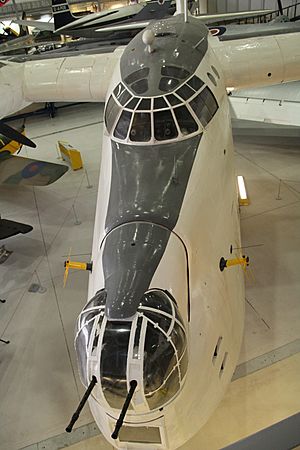
When Lucero was chosen, the height display showed signals from Lucero's antennas. There were two receiver antennas. One on each side of the plane. A motor quickly switched between them. One signal was also inverted. This made two blips appear on the screen. One on each side of the center line. The longer blip showed the direction of the ground beacon. By flying towards the longer blip, the plane could navigate to it.
Radar Performance
The performance of Coastal Command's operations was studied a lot during the war. Mark III was tested many times. In its first big tests, a prototype Mark III was flown against the powerful Mk. IIA. It was also tested against a 50 cm experimental system. The Mk. IIA could reliably detect a surfaced submarine at 14 miles (at 1,500 feet). It could see it at 7 miles when the submarine was mostly submerged.
The prototype Mark III, called "10 cm ASV," did much better. It could detect large convoys up to 40 miles away. This was true even when the plane flew low (500 feet). At this height, the plane was invisible to the ships. Other planes could be seen at 10 miles. Operators could guess their direction. Surfaced submarines were reliably detected at 12 miles (at 500 feet). These tests convinced Coastal Command to choose Mark III as their main system.
In November 1944, Mark III was compared to Mark VI and Mark VII. Using Grassholm Island as a target, Mk. III detected it at 23.5 miles. Mk. VI, with its stronger signals, improved this to 38.5 miles. Mk. VII, with less power, detected it at about 35 miles. Mk. III was estimated to detect a U-boat from the side at 22 miles. This improved to 32 miles for Mk. VI. For end-on targets, Mk. III's range was 10.5 miles. Mk. VI's was 20.5 miles.
See Also
- ASV Mark 7 radar
- H2S radar
- Leigh Light
- Metox radar detector
- Naxos radar detector
- Radar



